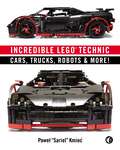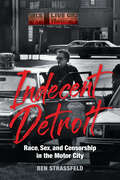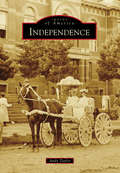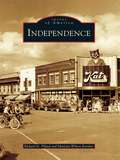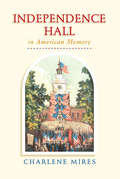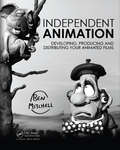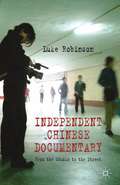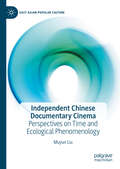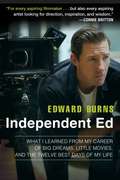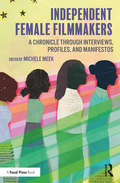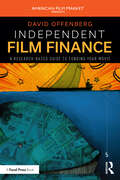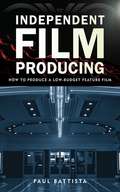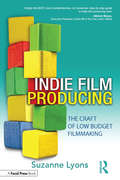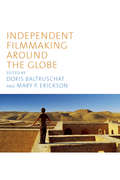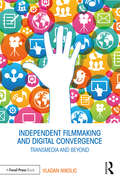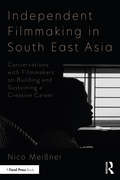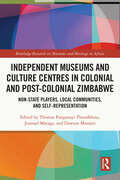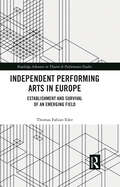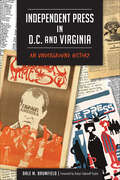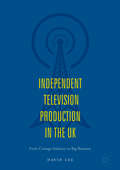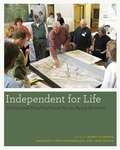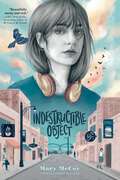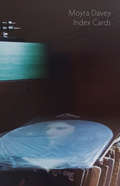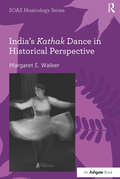- Table View
- List View
Incredible LEGO Technic: Cars, Trucks, Robots & More!
by Pawel Sariel KmiecFrom tanks to tow trucks, all the models showcased in this book use LEGO Technic gears, pulleys, pneumatics, and electric motors to really move. You’ll find some of the world’s best fan-created LEGO supercars, construction equipment, monster trucks, watercraft, and more, along with design notes and breakaway views of the truly incredible mechanisms inside.Look closely, and you’ll learn how expert builders use differentials, suspensions, linkages, and complex gearing systems in their creations.Whether you’re a beginning builder or a longtime LEGO fan, Incredible LEGO Technic offers a unique look at the artistry and engineering that can make your LEGO creations come alive.
Indecent Detroit: Race, Sex, and Censorship in the Motor City
by Ben StrassfeldWhile Detroit has been a major focus in urban history, little has been written on censorship in the very city that—due to shifting legalities, the urban crisis, and racial tensions—profoundly shaped media suppression in the United States. By examining censorship in film and literature, Indecent Detroit recounts the evolution of media control from the end of WWII through the 1970s, when the US saw a major change in the legal mechanisms used to censor media due to court rulings that curtailed censorship laws. Ben Strassfeld reveals how Detroit altered its censorial tactics and rhetoric from an obscenity-based system of censorship centered in the Detroit Police Department to a regulatory model based in zoning law that was then expanded nationwide. This shift was connected to broader social and political trends, including the sexual revolution, that led the public to increasingly turn against censorship. A must-read for film and media scholars, Indecent Detroit highlights how one Midwest city's ordinance was imitated across the country after it was upheld by the US Supreme Court, making this more than a local curiosity but also an influential model for the cultural, political, and moral control of urban space through media regulation.
Indefensible Space: The Architecture of the National Insecurity State
by Edited by MICHAEL SORKINShowing how the upswell of paranoia and growing demand for security in the post-9/11 world has paradoxically created widespread insecurity, these varied essays examine how this anxiety-laden mindset erodes spaces both architectural and personal, encroaching on all aspects of everyday life. Starting from the most literal level—barricades and barriers in front of buildings, beefed up border patrols, gated communities, "safe rooms,"—to more abstract levels—enhanced surveillance at public spaces such as airports, increasing worries about contagion, the psychological predilection for fortified space—the contributors cover the full gamut of securitized public life that is defining the zeitgeist of twenty-first century America
Independence
by Andy TaylorIndependence, Kansas, is the perfect picture of Americana. Where else can one find a small town that holds an annual theatre festival named in honor of one of its own natives, William Inge, or celebrates the early settlers in the Little House on the Prairie novels? Where can one find the site of the first-ever night game in organized baseball or the first team of one of baseball's most prolific hitters, Mickey Mantle? What other town in America can claim achievers like safari traveler Martin Johnson, oil magnate Harry Sinclair, presidential candidate Alf Landon, and even an astronaut chimp named Miss Abel? Lastly, where else can one find a town that holds a weeklong festival with the whimsical name Neewollah ("Halloween" spelled backward)?
Independence
by Richard Piland Marietta BoenkerFounded in 1827 as the county seat of Jackson County, Independence, "Queen City of the Trails," prospered through outfitting pioneers as they began the journey west on the Santa Fe, Oregon, and California Trails. The city persisted through various travails: a bloody war over slavery, fought between the Kansas Jayhawkers and the Missouri Bushwhackers; the rise of William Quantrill; the enforcement of the infamous Order No. 11; and Civil War action on the town square. By 1900, Independence was a prosperous community, the location of the headquarters of the Reorganized Church of Jesus Christ of Latter Day Saints (renamed the Community of Christ), and the hometown of a young man who became the 33rd president of the United States--Harry S. Truman. This book illustrates the history of Independence in more than 200 vintage images, detailing the people, businesses, churches, schools, organizations, and events that played important roles in the city's past.
Independence Hall in American Memory
by Charlene MiresIndependence Hall is a place Americans think they know well. Within its walls the Continental Congress declared independence in 1776, and in 1787 the Founding Fathers drafted the U.S. Constitution there. Painstakingly restored to evoke these momentous events, the building appears to have passed through time unscathed, from the heady days of the American Revolution to today. But Independence Hall is more than a symbol of the young nation. Beyond this, according to Charlene Mires, it has a long and varied history of changing uses in an urban environment, almost all of which have been forgotten.In Independence Hall, Mires rediscovers and chronicles the lost history of Independence Hall, in the process exploring the shifting perceptions of this most important building in America's popular imagination. According to Mires, the significance of Independence Hall cannot be fully appreciated without assessing the full range of political, cultural, and social history that has swirled about it for nearly three centuries. During its existence, it has functioned as a civic and cultural center, a political arena and courtroom, and a magnet for public celebrations and demonstrations. Artists such as Thomas Sully frequented Independence Square when Philadelphia served as the nation's capital during the 1790s, and portraitist Charles Willson Peale merged the arts, sciences, and public interest when he transformed a portion of the hall into a center for natural science in 1802.In the 1850s, hearings for accused fugitive slaves who faced the loss of freedom were held, ironically, in this famous birthplace of American independence. Over the years Philadelphians have used the old state house and its public square in a multitude of ways that have transformed it into an arena of conflict: labor grievances have echoed regularly in Independence Square since the 1830s, while civil rights protesters exercised their right to free speech in the turbulent 1960s. As much as the Founding Fathers, these people and events illuminate the building's significance as a cultural symbol.
Independent Animation: Developing, Producing and Distributing Your Animated Films
by Ben MitchellWith the advent of advanced hand-held technology and the widespread nature of the internet, the world of animated filmmaking is more exciting and accessible than ever. Due to this cultural and technological development, the success of independent animated film makers is on the rise. Independent Animation showcases some of the greatest, most innovated giants in the field and helps guide readers through the artistic process and production techniques. Story development, casting, color, distribution, and the intimidating aspects of production are elucidated using various examples from all over the world. Readers will also explore the changing nature of the audiences’ relationship with animation, granting firsthand guidance in navigating the diverse fields of animated film-making. <P><P>Key Features <P><P>Covers the entire process of creating an independent animated film, from story development and casting to editing and distribution <P><P>Features input from some of the industry’s most noteworthy animation talents and exclusive insight into their working processes <P><P>Additional resources and interviews available through a special section of Skwigly Online Animation Magazine
Independent Chinese Documentary
by Luke RobinsonThe rise of independent documentary film production is the most radical development in the contemporary Chinese mediascape. This book is a sustained examination of Chinese independent documentary in relation to one of its central principles: xianchang, or being 'on the scene'.
Independent Chinese Documentary Cinema: Perspectives on Time and Ecological Phenomenology (East Asian Popular Culture)
by Muyun LiuThis book explores the history of, and approaches to, documentary production within China from the Land Reform to the present day. It examines the institutionalisation of socialist realism during the PRC’s revolutionary era; considers the emergence of the fluid xianchang aesthetics and the creation of contingent subjectivities in relation to physicist Carlo Rovelli’s loop quantum gravity theory; explores two factory films through the angle of temporality; argues that time in the post-X era is multi-layered and can be experimented through a cinematic ruin aesthetics; and theorises ecological temporality in relation to Jean-Paul Sartre’s ontology on being as freedom and Caroline Godart’s analysis of difference.
Independent Ed
by Todd Gold Edward BurnsAn entertaining and inspirational memoir by one of the most prominent practitioners and evangelists of independent filmmaking, and the acclaimed writer, director, and actor (Saving Private Ryan, Friends with Kids, Entourage) whose first film--The Brothers McMullen--has become an indie classic. <P><P> At the age of twenty-five, Ed Burns directed and produced his first film on a tiny $25,000 budget. The Brothers McMullen went on to win the Grand Jury Prize at the Sundance Film Festival in 1995, and established the working-class Irish American filmmaker as a talent to watch. In the twenty years since, Burns has made ten more films (She's the One, Sidewalks of New York, and The Fitzgerald Family Christmas), while also acting in big budget Hollywood movies (Saving Private Ryan), hit television shows (Entourage and Mob City), and pioneering a new distribution network for indie filmmakers online and with TV's On Demand service ("why open a film in twenty art houses when you can open in twenty million homes?").<P> Inspired by Burns's uncompromising success both behind and in front of the camera, students and aspiring filmmakers are always asking Burns for advice. In Independent Ed, Burns shares the story of his two remarkable decades in a fickle business where heat and box office receipts are often all that matter. He recounts stories of the lengths he has gone to to secure financing for his films, starting with The Brothers McMullen (he told his father: "Shooting was the twelve best days of my life"). How he found stars on their way up--including Jennifer Aniston and Cameron Diaz--to work in his films, and how he's adhered religiously to the dictum of writing what you know, working as if he was just starting out, and always "looking for the next twelve best days of my life."
Independent Female Filmmakers: A Chronicle through Interviews, Profiles, and Manifestos
by Michele MeekIndependent Female Filmmakers collects original and previously published essays, interviews, and manifestos from some of the most defining and groundbreaking independent female filmmakers of the last 40 years. Featuring material from the seminal magazine The Independent Film and Video Monthly—a leading publication for independent filmmakers for several decades—as well as new interviews conducted with the filmmakers, this book, edited by Michele Meek, presents a unique perspective into the ethnically and culturally diverse voices of women filmmakers whose films span narrative, documentary, and experimental genres and whose work remains integral to independent film history from the 1970s to the present. Independent Female Filmmakers also includes a biographical profile of each filmmaker, as well as an online resource with links to additonal interviews and a sample course syllabus. The filmmakers in this book include: • Lisa Cholodenko (High Art, The Kids Are All Right) • Martha Coolidge (Valley Girl, Real Genius, Introducing Dorothy Dandridge) • Cheryl Dunye (The Watermelon Woman, Stranger Inside) • Miranda July (The Future, Me And You And Everyone We Know) • Barbara Kopple (Harlan County USA, Wild Man Blues) • Maria Maggenti (The Incredibly True Adventures of Two Girls in Love) • Deepa Mehta (Fire, Earth, Water) • Trinh T. Minh-ha (Surname Viet, Given Name Nam, Night Passage) . . . and more!
Independent Film Finance: A Research-Based Guide to Funding Your Movie (ISSN)
by David OffenbergFor aspiring producers and directors who need to learn film finance from the ground up, this revolutionary new book teaches the fundamentals, through the voices of more than 60 successful independent producers. Using a research and data-based approach, award-winning professor David Offenberg combines the wisdom of well-known and successful producers into one fun, easy-to-follow guide.Within, readers will learn how to talk to potential investors and what those financiers will expect from them in return. The book is also packed with informative anecdotes and examples to enrich each chapter and contextualize the film financing landscape. As the book progresses, equity, debt, revenue, profits, and their role in your movie will be explored. Accessible information about tax incentives and profit participations is included to help emerging filmmakers build out a workable financing plan. The book combines hard numbers and data sets, with direct guidance from successful producers, to construct a holistic overview on how you can turn your new-found financial knowledge into funding for your movie.This ground-breaking book is a must-read for any aspiring producer or director who wishes to gain an informed and easily digestible understanding of film finance.
Independent Film Producing: How to Produce a Low-Budget Feature Film
by Paul BattistaThe number of independent films produced each year has almost doubled in the past decade, yet only a fraction will succeed. If, like many filmmakers, you have no industry connections, little to no experience, and a low or ultra-low budget, this outsider's guide will teach you what you need to know to produce a standout, high-quality film and get it into the right hands. Written by an entertainment lawyer and experienced director and producer, this handbook covers all the most essential business, legal, and practical aspects of producing on a low budget, including:Scripts Business plansCopyright issuesEquity and non-equity financingFund-raisingTax considerationsTalent recruitingSchedulingDistribution Securities laws Film festivals And more Also discussed are the new crowd funding laws covered by the JOBS Act, making this book a must-read for every indie producer in today's economy. If you want to produce a film that gets attention, pick up the book that is recommended or required reading at film, business, and law schools from UCLA to NYU. Whether you're a recent film school graduate or simply a Hollywood outsider, Independent Film Producing will be like having a best friend who is an experienced, well-connected insider.
Independent Film Producing: The Craft of Low Budget Filmmaking
by Suzanne LyonsIndie Film Producing explains the simple, basic, clear cut role of the independent film producer. Raising funds to do your dream project, producing award-winning films with a low budget, putting name actors on your indie film-it's all doable, and this book guides you through the entire process of being a successful producer with bonus tips on how to effortlessly maneuver through the sphere of social media marketing and fundraising tactics. Indie film producer Suzanne Lyons pilots you through the actual making of low budget films to show you how easy and fun it can be. Laid out in a step-by-step, A to Z, matter-of-fact style that shows how the producer's role can be easy, how to treat the film as a business, and especially how to avoid the painful pitfalls faced by so many producers, this book gives you the essential tools you need to make your film a success from the ground up. . Begins with the earliest stages of concept development, continues through production & post, and ultimately concludes with distribution . Shows you how to create a buzz for your film through marketing and promotions . Interviews with global producers who produced films using social media, festivals, apps, and more, give you real-world insight that can be applied to your own films . Website points you to a fantastic collection of resources that you'll need to produce your own films (http://booksite.focalpress.com/indiefilmproducing)
Independent Filmmaking Around the Globe
by Mary P. Erickson Doris BaltruschatIndependent Filmmaking around the Globe calls attention to the significant changes taking place in independent cinema today, as new production and distribution technology and shifting social dynamics make it more and more possible for independent filmmakers to produce films outside both the mainstream global film industry and their own national film systems. Identifying and analyzing the many complex forces that shape the production and distribution of feature films, the authors detail how independent filmmakers create work that reflects independent voices and challenges political, economic, and cultural constraints.With chapters on the under-explored cinemas of Greece, Turkey, Iraq, China, Malaysia, Peru, and West Africa, as well as traditional production centres such as the United States, the United Kingdom, Canada, and Australia, Independent Filmmaking around the Globe explores how contemporary independent filmmaking increasingly defines the global cinema of our time.
Independent Filmmaking and Digital Convergence: Transmedia and Beyond
by Vladan NikolicIndependent Filmmaking and Digital Convergence: Transmedia and Beyond offers a comprehensive analysis of the technological changes of the past few decades in independent film and media-making, and explores new strategies and practices in media production, exhibition and distribution for independent producers and content creators. The book examines how independent filmmaking concepts have merged with digital and online technologies to create new hybrid multi-platform content creations. It explores key questions like how to reach an audience at a time when media conglomerates and their products dominate the market, and simultaneously, there is an overabundance of content competing for viewer time. The book investigates what kind of stories we tell and why; how the audience has changed, and what their expectations are; what the various niche markets are for independent producers and creators in new media; and new models for media financing and distribution. The content found in this book: Bridges the gap between professional media-makers and amateurs by focusing on new and emerging media models and practices. Provides a holistic view of the new media landscape, and practical advice on producing content in the new multi-platform media environment. Demonstrates how to create financially sustainable models for independent producers and creators in a shifting and unstable environment, providing many challenges, but also opportunities for independents. The author's website (http://www.filmconvergence.com/) supports this book with case studies, news and updates.
Independent Filmmaking in South East Asia: Conversations with Filmmakers on Building and Sustaining a Creative Career
by Nico MeissnerFeaturing interviews with 27 award-winning and emerging filmmakers, this book is the first comprehensive look at independent filmmaking careers in South East Asia with never-before published insights into the lives and careers of some of the most influential filmmakers in one of the world’s most exciting screen production regions.Celebrating filmmaking in South East Asia, the interviews offer unique perspectives that highlight the various paths filmmakers have taken to establish and develop their independent filmmaking careers. Presenting filmmakers whose films span narrative, documentary and experimental genres, and from all ten South East Asian nations, the filmmakers in this collection include: Camera d’Or winner Anthony Chen Sundance Grand Jury Prize nominee Mouly Surya NETPAC Award Winner Sheron Dayoc Brunei’s first female director, Siti Kamaluddin Directors of the Wathann Festival, Thaiddhi and Thu Thu Shein Lao’s only female and first horror film director, Mattie Do Aimed at aspiring filmmakers with a focus on career building outside of global production hubs, Meißner has curated a collection of interviews that reflects the diversity and ambition of filmmaking in South East Asia. The book is accompanied by a companion website (www.southeastasianfilmcareers.com) that includes 27 micro-documentaries on the included filmmakers.
Independent Museums and Culture Centres in Colonial and Post-colonial Zimbabwe: Non-State Players, Local Communities, and Self-Representation (Routledge Research on Museums and Heritage in Africa)
by Thomas Panganayi ThondhlanaIndependent Museums and Culture Centres in Colonial and Post-colonial Zimbabwe presents case studies that grapple with the issue of ‘decolonising practice’ in privately owned museums and cultural centres in Zimbabwe. Including contributions from academics and practitioners, this book focusses on privately run cultural institutions and highlights that there has, until now, been scant scholarly information about their existence and practice. Arguing that the recent resurgence of such museums, which are not usually obliged to endorse official narratives of the central government, points to some desire to decolonise and indigenise museums, the contributors explore approaches that have been used to reconfigure such colonially inherited institutions to suit the post-colonial terrain. The volume also explores how privately owned museums can tap into or contribute to current conversations on decoloniality that encourage reflexivity, inclusivity, de-patriarchy, multivocality, community participation, and agency. Exploring the motives and purpose of such institutions, the book argues that they are being utilised to confront deeply entrenched stigmatisation and marginalisation. Independent Museums and Culture Centres in Colonial and Post-colonial Zimbabwe demonstrates that post-colonial African museums have become an arena for negotiating history, legacies, and identities. The book will be of interest to academics and students around the world who are engaged in the study of museums and heritage, African studies, history, and culture. It will also appeal to museum practitioners working across Africa and beyond.
Independent Performing Arts in Europe: Establishment and Survival of an Emerging Field (Routledge Advances in Theatre & Performance Studies)
by Thomas Fabian EderThis structural account of independent performing arts in Europe is complimented by an analysis of the challenging social situation within the field. This book presents a neo-institutional examination of the organizational field including its routines, scripts, and expectations which provides a contribution to theatre studies, labour studies, and to social and cultural policy studies as well as valuable context for current advocacy and governance. This study offers knowledge based on empirical data and thus a foundation that is equally important for scholarly discourse, cross-national learning, and scientifically based recommendations for action to administration, the cultural policy level, and associations alike. The book examines the independent performing arts communities in Austria, Bulgaria, the Czech Republic, Finland, Germany, Hungary, Iceland, Italy, Romania, Slovenia, Sweden and Switzerland.
Independent Press in D.C. and Virginia: An Underground History
by Dale M. BrumfieldThe nation's capital and the state of Virginia were a hotbed of political and social turmoil that marked the 1960s and 1970s. The area saw anti-Vietnam War protests, civil rights marches and students clamoring for a cultural revolution. Underground publications in D.C. and Virginia sprang up to document the radical change and question the "straight media." Off Our Backs led the charge for women's equality. The Gay Blade fought for the rights of homosexuals. Even the FBI began infiltrating the underground press movement by planting informants and creating fake magazines to attract suspicious "radicals." Join author and former underground editor Dale Brumfield as he traces the history of alternative press in the Commonwealth and the District.
Independent Television Production in the UK: From Cottage Industry To Big Business
by David LeeThis book is the first authoritative account of the UK’s independent television production sector, following the creation of Channel 4 in 1982. It examines the rise of a global industry, increasingly interconnected through format development, distribution, ancillary sales and rights. Drawing on case studies, interviews and policy analysis; the author considers the cultural politics behind the growth of the ‘indies’, the labour conditions for workers in this sector, and some of the key television programmes that have been created within it. Filling an important gap in our understanding, this book constitutes a comprehensive account of this vital cultural industry for students, academics and researchers working in the areas of the cultural and creative industries, media and cultural policy and television studies.
Independent for Life: Homes and Neighborhoods for an Aging America
by Henry Cisneros Margaret Dyer-Chamberlain Jane HickieDo you want to age independently in your own home and neighborhood? Staying home, aging in place, is most people's preference, but most American housing and communities are not adapted to the needs of older people. And with the fastest population growth among people over 65, finding solutions for successful aging is important not only for individual families, but for our whole society. In Independent for Life, former HUD Secretary Henry Cisneros and a team of experts on aging, architecture, construction, health, finance, and politics assess the current state of housing and present new possibilities that realistically address the interrelated issues of housing, communities, services, and financial concerns. Independent for Life covers a wide range of smart solutions, including remodeling current housing and building new homes for accessibility and safety, retrofitting existing neighborhoods to connect needed services and amenities, and planning new communities that work well for people of all ages. Case studies show how the proposals can be implemented. The authors offer action plans for working with policy makers at local, state, and national levels to address the larger issues of aging in place, including family financial security, real estate markets, and the limitations of public support. Lists of essential resources, including a detailed "to do" list of aging in place priorities and an individual home assessment, complete the volume.
Indestructible Object
by Mary McCoy&“Beautifully messy and real.&” —Amy Spalding, bestselling author of We Used to Be Friends Perfect for fans of What If It&’s Us and Mary H. K. Choi, this stunning coming-of-age novel from Printz Honor author Mary McCoy follows a Memphis teen whose quest to uncover the secrets of love reveals new truths about herself.For the past two years, Lee has been laser-focused on two things: her job as a sound tech at a local coffee shop and her podcast Artists in Love, which she cohosts with her boyfriend Vincent. Until he breaks up with her on the air right after graduation. When their unexpected split, the loss of her job, and her parent&’s announcement that they&’re separating coincide, Lee&’s plans, her art, and her life are thrown into turmoil. Searching for a new purpose, Lee recruits her old friend Max and new friend Risa to produce a podcast called Objects of Destruction, where they investigate whether love actually exists at all. But the deeper they get into the love stories around them, the more Lee realizes that she&’s the one who&’s been holding love at arm&’s length. And when she starts to fall for Risa, she finds she&’ll have to be more honest with herself and the people in her life to create a new love story of her own. Funny, romantic, and heartfelt, this is a story about secrets, lies, friendship, found family, an expired passport, a hidden VHS tape, fried pickles, the weird and wild city of Memphis, and, most of all, love.
Index Cards: Selected Essays
by Moyra DaveyAn essential selection of Moyra Davey’s sly, surprising, and brilliant essays In these essays, the acclaimed artist, photographer, writer, and filmmaker Moyra Davey often begins with a daily encounter—with a photograph, a memory, or a passage from a book—and links that subject to others, drawing fascinating and unlikely connections, until you can almost feel the texture of her thinking. While thinking and writing, she weaves together disparate writers and artists—Mary Wollstonecraft, Jean Genet, Virginia Woolf, Janet Malcolm, Chantal Akerman, and Roland Barthes, among many others—in a way that is both elliptical and direct, clearheaded and personal, prismatic and self-examining, layering narratives to reveal the thorny but nourishing relationship between art and life.
India's Kathak Dance in Historical Perspective (SOAS Studies in Music)
by Margaret E. WalkerKathak, the classical dance of North India, combines virtuosic footwork and dazzling spins with subtle pantomime and soft gestures. As a global practice and one of India's cultural markers, kathak dance is often presented as heir to an ancient Hindu devotional tradition in which men called Kathakas danced and told stories in temples. The dance's repertoire and movement vocabulary, however, tell a different story of syncretic origins and hybrid history - it is a dance that is both Muslim and Hindu, both devotional and entertaining, and both male and female. Kathak's multiple roots can be found in rural theatre, embodied rhythmic repertoire, and courtesan performance practice, and its history is inextricable from the history of empire, colonialism, and independence in India. Through an analysis both broad and deep of primary and secondary sources, ethnography, iconography and current performance practice, Margaret Walker undertakes a critical approach to the history of kathak dance and presents new data about hereditary performing artists, gendered contexts and practices, and postcolonial cultural reclamation. The account that emerges places kathak and the Kathaks firmly into the living context of North Indian performing arts.
